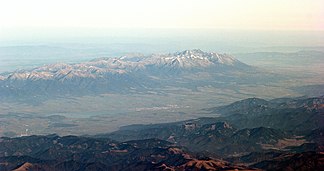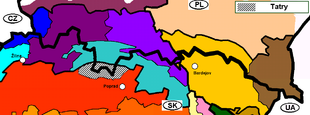Tatra Mountains
| Tatra Mountains | ||
|---|---|---|
|
Aerial photo: View of the High Tatras from the south (Slovakia) |
||
| Highest peak | Gerlachovský štít ( Gerlsdorfer Peak ) ( 2654.4 m nm ) | |
| location | Slovakia, Poland | |
| part of | Western Carpathians | |
|
|
||
| Coordinates | 49 ° 10 ′ N , 20 ° 8 ′ E | |
Tatra ( Slovak and Polish Tatry ) is the name of a mountain complex of the geological Fatra-Tatra area in the Carpathian Mountains , which includes the Great and Little Fatra in addition to the Tatra Mountains . Two thirds of the area of the Tatras are in Slovakia and one third in Poland (the Rysy with 2503 m nm on the Slovak side is the highest peak in Poland with 2499.6 m npm ). At 2654.4 m nm , the Gerlachovský štít ( Gerlsdorf peak ) in Slovakia is the highest point in the Tatra Mountains, Slovakia and the entire Carpathian Mountains. Only there, in their northernmost part, the High Tatras , and in the southern part, the Făgăraş Mountains , the Retezat , the Parâng Mountains and the Bucegi Mountains , do the Carpathian peaks reach heights of over 2500 m. In total there are more than 40 peaks over 2000 m in Slovakia .
The Tatra Mountains consist of:
- the West Tatras (German also: Liptauer Alpen , Slovak Západné Tatry , Polish Tatry Zachodnie ),
- the Eastern Tatras (Slovak Východné Tatry , Polish Tatry Wschodnie ), which in turn consists of the High Tatras (Slovak Vysoké Tatry , Polish Wysokie Tatry ) in the west and the Beler Limestone Alps (also Belaer Tatra , Slovak Belianske Tatry , Polish Tatry Bielskie ) in the east .
To distinguish from the Tatra is the Low Tatras , by the Tatra by the rivers Vah ( Vah ) and Poprad ( Popper -carrying) Talsenke Podtatranská kotlina is disconnected. In this basin, the landscapes are Liptov ( Liptov ) and Zips (sl. Spiš , pl. Spisz ). To the west of the Tatras is the Orava region (pl. Orawa ), to the north is the Podhale region and the Gorce and Beskydy mountain ranges .
Colloquially, both the West and East Tatras and the Low Tatras are referred to as “Tatry” (especially since the word “Tatry” is used in the plural in Slovak and Polish today), or only the High Tatras are referred to as Tatry.
geology
The central part of the Tatra Mountains consists of granite , followed by sedimentary rocks of limestone , dolomite , claystone and slate . The mountain formation of the Tatras was largely caused by a rift fracture in the area of the Southern Tatras , which appeared around 15 million years ago and gave the mountains a height of around 6 km. It separates the Tatras from the Liptov and Poprad basins . For this reason the Tatras have no foothills . The face of the mountains was shaped by the cold ages over the last 2 million years . Glaciers pushed their way into the granite of the Tatra Mountains and left trough valleys that end with moraines and filled with water after the ice age glaciers had melted.
climate
The Tatras and their surroundings are the coldest areas in Slovakia. The wind usually blows from the northwest. Due to the location of the mountains, a rain shadow is created on the leeward side in the Poprad basin . The annual rainfall is around 300 mm.
rivers and lakes
The two source rivers of the Dunajec , which flows to the northeast, and the Poprad ( Popper ), which initially flows to the southeast and flows into the Dunajec at Nowy Sącz, arise in the Tatras . The Dunajec is a right tributary of the Vistula . There are about 200 glacial lakes in the Tatras. The best known are the sea eye in Poland, and on the Slovak side of the Štrbské pleso ( Tschirmer lake ), which is located at the winter sports resort of the same name, the Poprader lake, the Steinbach lake (Skalnaté pleso) and the green lake (Zelené pleso). Other large lakes are Czarny Staw Gąsienicowy ( Black Gąsienicowa Lake ), Wielki Staw Polski ( Great Polish Lake ) in Dolina Pięciu Stawów Polskich ( Valley of the Five Polish Lakes ) and Czarny Staw pod Rysami ( Black Lake under the Meeraugspitze ).
Hiking trails
In both Poland and Slovakia, the mountains are easily accessible by hiking trails. In Poland, the highest point in the mountains that can be reached via hiking trails is the Rysy , a well-known and difficult route is Orla Perć . In Slovakia, the core area of the High Tatras forms a nature park, in which leaving the hiking trails is only allowed with a guide. Independent mountaineering is therefore not possible.
In Slovakia, hiking trails in the Tatras above the mountain huts are closed from November 1st to June 15th. In Poland, the hiking trails are open all year round.
Economy and Infrastructure
The largest and most famous city on the Polish side is Zakopane . On the Slovak side are the well-known winter sports and mountain health resorts of Tatranská Lomnica (German: Tatralomnitz ), Starý Smokovec (German: Altschmecks ) and Štrbské Pleso (German: Lake Tschirmer ). The D1 motorway runs from Bratislava to Košice on the southern periphery of the mountains .
National park
In 1949 the Tatra National Park (TANAP) was founded on the Slovak side of the Tatra Mountains , followed by the designation of the Tatra National Park (TPN) on Polish territory in 1954 . Both parks together cover a total area of 113,000 ha and have been declared an international biosphere reserve by UNESCO . They accommodate over 1300 recorded plant species of different zonal vegetation types, from beech forest communities to vegetation forms in alpine climatic zones.
The fauna includes all the typical carnivores of the Carpathian Mountains , including the European wildcat , lynx , wolf and brown bear . There are also some distinctive bird species such as the common pine jay .
Others
On November 19, 2004, a strong hurricane with wind speeds of up to 150 km / h destroyed large parts of the spruce forest in the High Tatras on the Slovak side.
High Tatras - Relief Map 1: 50,000
Tatra Mountains, view from Rysy on the border between Poland and Slovakia
On August 17, 2019, 6 researchers entered the Wielka-Sniezna Cave in the limestone in southern Poland, 4 fled the cave, and of 2 missing persons, one was found dead in the cave on August 23.
See also
Web links
- Polish Tatra Mountains
- Tatra National Park Poland (English)
- Tatra National Park Slovakia (English)
- Valley of the Five Polish Lakes
Individual evidence
- ↑ Dead body of missing researcher found in Polish cave orf.at, 23 August 2019, accessed 23 August 2019.







